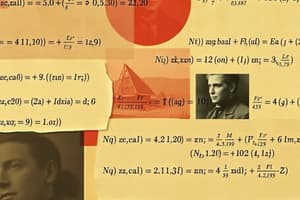Podcast
Questions and Answers
What is the formula for Average Fixed Cost?
What is the formula for Average Fixed Cost?
- ATC - AVC (correct)
- AVC + AFC
- TFC + TVC
- TFC ÷ Qs (correct)
What is Average Variable Cost?
What is Average Variable Cost?
TVC ÷ Qs
How is Average Total Cost calculated?
How is Average Total Cost calculated?
AVC + AFC
What is the formula for Average Product?
What is the formula for Average Product?
What does Marginal Cost represent?
What does Marginal Cost represent?
How is Marginal Product calculated?
How is Marginal Product calculated?
What is the formula for Total Cost?
What is the formula for Total Cost?
How is Total Revenue calculated?
How is Total Revenue calculated?
What does Total Product equal?
What does Total Product equal?
How is Average Revenue calculated?
How is Average Revenue calculated?
What is the formula for Marginal Revenue?
What is the formula for Marginal Revenue?
What does XED (Cross-price Elasticity) represent?
What does XED (Cross-price Elasticity) represent?
What does YED (Income Elasticity) measure?
What does YED (Income Elasticity) measure?
How is PED (Elasticity of Demand) calculated?
How is PED (Elasticity of Demand) calculated?
What identifies the Break Even Point?
What identifies the Break Even Point?
What defines Productively Efficient?
What defines Productively Efficient?
What does Allocatively Efficient mean?
What does Allocatively Efficient mean?
How is profit maximized?
How is profit maximized?
What defines the point to Maximise Revenue?
What defines the point to Maximise Revenue?
What indicates the Socially Optimal Point?
What indicates the Socially Optimal Point?
How is Marginal Revenue Product calculated for perfect competition?
How is Marginal Revenue Product calculated for perfect competition?
What does Marginal Factor/Resource Cost represent?
What does Marginal Factor/Resource Cost represent?
Flashcards are hidden until you start studying
Study Notes
Average Fixed Cost (AFC)
- Calculated by dividing Total Fixed Cost (TFC) by Quantity Supplied (Qs).
- Can also be found by subtracting Average Variable Cost (AVC) from Average Total Cost (ATC).
Average Variable Cost (AVC)
- Determined by dividing Total Variable Cost (TVC) by Quantity Supplied (Qs).
- Can be calculated by subtracting Average Fixed Cost (AFC) from Average Total Cost (ATC).
Average Total Cost (ATC)
- Sum of Average Variable Cost (AVC) and Average Fixed Cost (AFC).
Average Product (AP)
- Computed as Total Product (TP) divided by the number of units of labor employed.
Marginal Cost (MC)
- Represents the change in Total Cost (TC) when quantity supplied (Qs) increases by one unit.
Marginal Product (MP)
- Calculated as the change in Total Product (TP) divided by the change in labor.
Total Cost (TC)
- The sum of Total Fixed Cost (TFC) and Total Variable Cost (TVC).
Total Revenue (TR)
- Calculated by multiplying price (P) by Quantity Supplied (Qs).
Total Product (TP)
- The difference between Total Revenue (TR) and Total Cost (TC), indicating net production output.
Average Revenue (AR)
- Found by dividing Total Revenue (TR) by Quantity Supplied (Qs).
Marginal Revenue (MR)
- Represents the change in Total Revenue (TR) when the quantity supplied (Qs) is increased by one unit.
Cross-price Elasticity of Demand (XED)
- Calculated using the percentage change in quantity demanded of good 1 (QD of G₁) over the percentage change in price of good 2 (P of G₂).
- A negative value indicates goods are complementary, while a positive value indicates they are substitutes.
Income Elasticity of Demand (YED)
- Calculated using the percentage change in quantity demanded (QD) over the percentage change in income (Y).
- A negative value classifies goods as inferior, and a positive value classifies them as normal.
Price Elasticity of Demand (PED)
- Computed as the percentage change in quantity demanded (QD) divided by the percentage change in price (P).
Break Even Point
- Identified where Average Total Cost (ATC) intersects with demand (D).
Productive Efficiency
- Achieved when a firm operates at the lowest Average Total Cost (ATC).
Allocative Efficiency
- Occurs when price (P) equals marginal cost (MC), indicating optimal distribution of resources.
Profit Maximization
- Achieved at the point where Marginal Cost (MC) equals Marginal Revenue (MR).
Revenue Maximization
- Occurs when Marginal Revenue (MR) equals zero, indicating no additional revenue from selling more output.
Socially Optimal Point
- Achieved when Marginal Cost (MC) equals demand (D), maximizing societal welfare.
Marginal Revenue Product (MRP)
- The change in revenue associated with hiring one additional worker is calculated as Marginal Product (MP) multiplied by price (P) for perfect competition, or MP multiplied by Marginal Revenue (MR) for imperfect competition.
Marginal Factor/Resource Cost (MFC)
- The additional cost incurred by employing one more unit of labor or machine, computed as the change in Total Cost (TC) divided by the change in labor (L).
Studying That Suits You
Use AI to generate personalized quizzes and flashcards to suit your learning preferences.




